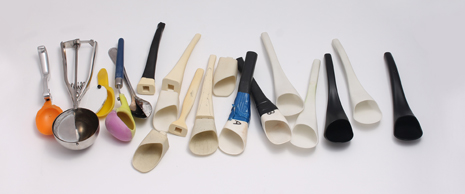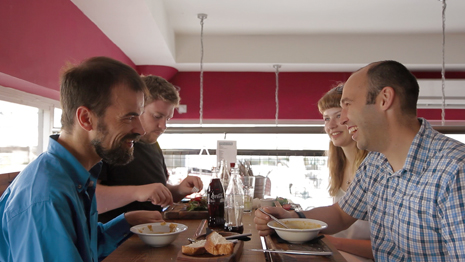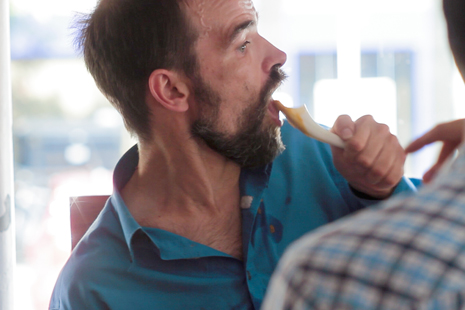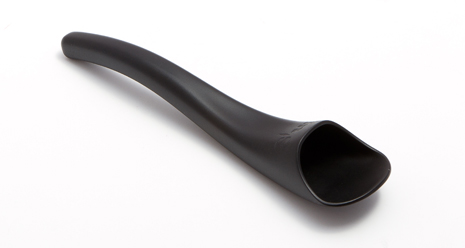
The hope is that through the Kickstarter campaign the £33,000 target will be met to take the S’up Spoon into manufacture
What began as a spoon redesign project between Mark Penver, an intern at Glasgow product design consultancy 4c design, and Grant Douglas, a man with cerebral palsy, has become a Kickstarter project.
Unlike traditional spoons, the S’up Spoon has a deeper cavity to hold contents more securely and reduce spillage.
Although designed for those whose movements and coordination are affected by cerebral palsy, Parkinson’s or essential tremor, the spoon’s sleek design and matte black finish does not single it out as an assistive device.
The S’up Spoon project began a year ago when Mark Penver, a graduate from Northumbria University, started his internship at 4c (he has since become a permanent member of staff).
All interns are given a project to complete, from first concepts through to a one-off prototype. In this instance, Robin Smith, 4c’s managing director, had met Douglas through a friend who’d told him about his idea for a spoon. This inclusive design project sounded perfect for an intern and so Penver was set to work.
The starting point was a meeting with Douglas to understand the difficulties he had eating with a traditional spoon.
“I have extremely limited use of my right hand and the level of control over my left hand is nothing like what non-disabled people have.
“I can manage to get whatever I want on to a spoon but by the time I get the spoon to my mouth the food is either on the floor, table, wall – anywhere apart from on the spoon.
“I can just about manage things like ice-cream or moist cake as they ‘stick’ to the spoon, but cereals, soups, peas and corn are literally impossible, especially when eating out,” explains Douglas.
Douglas’ original idea for the spoon was something a bit like an ice-cream scoop. Penver did prototype one up but soon realised that it did not offer a suitable solution.
“Being engineers, we got excited about mechanisms but it soon became apparent that form was the best route to take with this project,” admits Penver.

Basically this is how the S’up Spoon works
From sketches, he moved quickly into SolidWorks creating a range of spoon heads and handles.
“A lot of assistive and inclusive products are tubular and often have very big grips but we realised from talking to Grant Douglas that it doesn’t need to have such a big grip.
“We also worked on the curvature of the handle. So when the spoon is on the table you have a larger area to grip because it is raised off the surface,” adds Penver.

The range of prototypes from early ones that were bastardised from existing products to the final polished form
A number of prototypes were created consisting of a a variety of plug ’n play 3D printed heads and foam handles, which were carved in the workshop. When Douglas decided which of the variations worked best for him, 4c worked on creating two of them into a final prototype.

Handing Douglas a box consisting of the two final S’up Spoon prototypes
Just before Christmas 2013, Douglas visited 4c where he was handed a box with the prototypes.
“These prototypes have enabled me to have soup (on Boxing Day I had a whole bowl of soup without spilling a drop); my breakfast has changed from toast/crumpets to Weetabix; and I can enjoy a hassle-free Chinese with my friends. These are but a few ways that the S’up Spoon has changed my eating habits,” says Douglas.

Douglas can now enjoy food with friends and not have to worry about spilling. Here he is with members of the 4c design team

Using the spoon that has transformed his eating habits and lifestyle
The project was over as the final prototype had been delivered to the ‘client’ but 4c couldn’t let it go that easily. As Penver says, “We received such positive feedback from Grant and how those two prototypes transformed his eating patterns. That was when we thought that this product could be really worthwhile to other people too such as those who suffer from essential tremor, have Parkinson’s or even those who have less control due to old age.”
So, Penver went back to the SolidWorks files as he realised that some changes would need to be made. Firstly, it was designed for left handed users because that is what Douglas is. Secondly, it did look rather, so Penver worked on creating a softer and rounder aesthetic.
Originally 4c was planning to use polypropylene as the material and Protomold as the manufacturer. However, the team discovered that some foods, especially wet cornflakes, would stick inside the cavity when the spoon was tipped.
Having tested different materials including stainless steel, they discovered a plastic called tritan.
“Sporks are made out of tritan and it was just by luck that one of the guys had a spork in the workshop. From that point everything changed because to use this material we would have to use another manufacturer and tooling costs would be a lot more expensive than Protomold,” explains Penver.
It was at this point that 4c decided to launch a Kickstarter campaign to raise the £33,000 to fund the aluminium tool so it can produce the spoon using injection moulding.
https://www.kickstarter.com/projects/4cdesign/eat-more-chat-more-spill-less-a-spoon-for-shaky-ha/widget/video.html
The Kickstarter video
The funding period will end on 2 October and if the goal is met, 4c intend to distribute the first batch of online orders before Christmas 2014.
4c do realise that although spreading the word via the S’up Spoon twitter account and online forums has been useful, it is the S’up Spoon Facebook page that has been particularly useful in drawing it the attention of the target users.
“Facebook is where conversations happen and on our Facebook page we’ve had people share touching stories. And it’s not just cerebral palsy sufferers, but others who see a benefit in using this product. That has made us want to work even harder to get this product out there and helping people,” says Penver.






